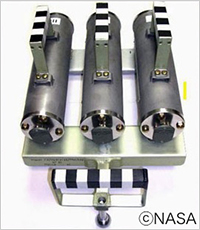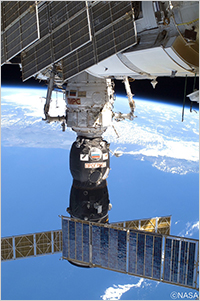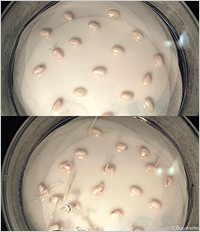Enlarge Image Figure 2. Docking compartment of International Space Station where rice seeds were exposed to outer space. (Photo by NASA).
Enlarge Image Figure 3. Rice seeds stored in space (upper) and on Earth (lower) 5 days after imbibition.
Enlarge Image
Growing rice in space: Insights into effect of space environment on seed viability
Successfully sustaining edible plants in space is an important factor for sustaining long-term human habitation in this unique and hostile environment with intense fluctuations in temperature and harmful radiation. Recent research on growing plants in space has highlighted the importance of germination, the stage where seeds grow into plants, with reports of negative effects of the space environment on germination. However, it is still not clear how the space environment effects genes that regulate a plants biological processes during germination. Therefore, understanding the effects of space environment on genes governing germination is expected to give insights into biological mechanisms determining seed viability in space.
With this background, Manabu Sugimoto at Okayama University and colleagues compared four groups of rice seeds. Two groups were stored outside the International Space Station (for 13 and 20 months) and the two corresponding groups were stored on Earth. After exposure to space environment, all the groups of rice were germinated on Earth. The researchers designed experiments to determine germination efficiency and variance in genes.
The researchers found that data from four batches showed that longer exposure of seeds in space yielded to improper and delayed germination. Notably, these seeds also exhibited decrease of long-lived mRNAs. This was an important finding because successful germination requires rapid resumption of metabolic activity.
This research showed that viability of seeds was directly related to the length of time the seeds were exposed to the space environment. Furthermore, optimum germination efficiency was achieved in space by limiting the exposure time of the seeds, where shorter space exposure, led to fewer genetic alterrations in the seeds.
Reference:
Manabu Sugimoto a,1, Youko Oono b,1, Yoshihiro Kawahara b, Oleg Gusev c, Masahiko Maekawa a, Takashi Matsumoto b, Margarita Levinskikh d, Vladimir Sychev d, Natalia Novikova d, Anatoly Grigoriev d, Gene expression of rice seeds surviving 13- and 20-month exposure to space environment, Life Sciences in Space Research 11, 10–17, (2016).
http://dx.doi.org/10.1016/j.lssr.2016.10.001
a Institute of Plant Science and Resources, Okayama University, 2-20-1 Chuo, Kurashiki, Okayama 710-0046, Japan
b National Institute of Agrobiological Sciences, 2-1-2 Kannondai, Tsukuba, Ibaraki 305-8602, Japan
c Preventive Medicine & Diagnosis Innovation Program, RIKEN, 2-1 Hirosawa, Wako, Saitama 351-0198, Japan
d Institute of Biomedical Problems of Russian Academy of Sciences, 76a Khorosheevskoe shosse, Moscow 123007, Russia
Corresponding author
E-mail addresses: manabus@rib.okayama-u.ac.jp (M.Sugimoto).



